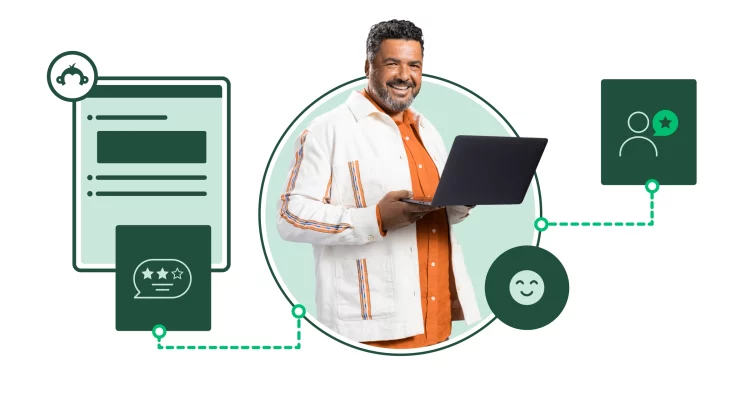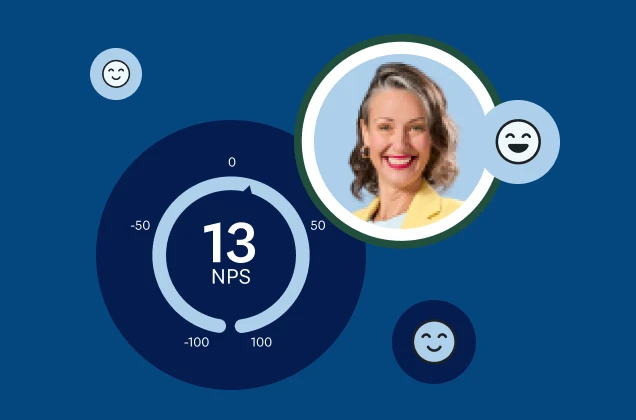10 strategies to maximize the ROI of your CX programs
How to calculate and improve the ROI of your customer experience efforts.

Customer experience (CX) professionals face an ever-growing challenge: keeping pace with customers’ evolving needs and expectations. Nearly half of CX professionals say that meeting and exceeding customer expectations is a top challenge for their team.
While companies strive to deliver exceptional experiences, they often find themselves misaligned with consumer perceptions, leading to missed opportunities and diminished customer satisfaction.
To bridge this gap, CX professionals are implementing customer feedback programs—such as Customer Satisfaction Score (CSAT), Net Promoter Score® (NPS), and Customer Effort Score (CES)—that allow them to identify areas of improvement and measure their performance against their goals.
But merely collecting feedback isn’t enough. You must also leverage the insights you glean to enhance the success of your CX program and drive more return on investment (ROI). Keep reading to learn more about CSAT, NPS, CES, and strategies to drive more revenue from your CX program.
Measure the top 3 CX metrics
Customer Satisfaction Score
Customer Satisfaction Score is a customer loyalty metric obtained by asking: “How satisfied are you with the service you received today?” A simple rank of 1-10 interprets seamlessly into a percentage score.
CSAT is a good indication of projected customer loss. For example, a customer who responds to the survey with a score of 1 is unlikely to return.
However, a customer that experiences exceptional service is more likely to respond to the CSAT survey with a high score and become loyal to your business. Loyal customers increase profitability and are more likely to recommend your [business/product/service] to friends and family.
Net Promoter Score
Net Promoter Score determines how loyal a customer is to a brand, how likely a customer is to recommend a company, and how satisfied a customer is with the products and services offered by a company. Each answer gets scored on a 0-10 scale. For example, an NPS survey may ask:
- "On a scale of 0 to 10, how likely are you to recommend our [product/service/company] to a friend or colleague?"
- “Based on your recent purchase, on a scale of 0 to 10, how likely are you to recommend our [product/service/company] to a friend or colleague?”
Based on their response, respondents are categorized into three groups: active promoters (who rated 9-10), passives (who rated 7-8), and detractors (who rated 0-6).
Some NPS surveys may also incorporate an open-ended question to have the customer provide more detail on their NPS response.
Customer Effort Score
Customer Effort Score showcases how easy or difficult it was for a customer to interact with your business. CES is best used in customer service or other routine experiences where low effort is the main driver of loyalty or satisfaction.
The CES survey asks customers to agree or disagree with the statements (and more!):
- “[Company name] made it easy for me to handle my issue.”
- “How easy was it for you to find the information you were looking for on our website or app?”
Answer choices range from strongly disagree to strongly agree. CES surveys are most often deployed immediately after purchase, after customer service interaction, or online to gauge the level of effort necessary to browse a website or app.
CES surveys are a valuable tool for understanding and improving the customer experience, particularly when it comes to reducing customer frustration and making interactions with a company as frictionless as possible.

10 strategies to improve customer experience ROI
#1: Create a customer journey map
Building a customer journey map is a strategic process that enables organizations to visualize the entire customer experience, from the initial awareness to onboarding to renewal or repurchasing. These visual representations help to:
- Highlight areas of friction and frustration in the customer experience
- Provide insight into customer needs, behaviors, and preferences
- Uncover redundancies and streamline processes
- Facilitate cross-functional collaboration
By analyzing the complete journey, businesses can make data-driven decisions to enhance customer satisfaction, drive loyalty, and ultimately, improve overall business performance.
#2: Understand why customers leave
Implement a win/loss customer survey when customers leave to ask about the customer experience, why they stopped working with you, and what they did or did not like. The data collected from previous customers exposes weaknesses in the customer experience and creates a benchmark for improvement to calculate experience-boosting interventions.
#3: Add personalized touchpoints in the customer journey
Thirty-four percent of CX pros say their company is prioritizing personalization at critical points in the customer journey. Delivering great personalized customer experiences means building products, services, and interactions—obtained from customer data points like purchase history, industry, location, etc.—that meet your customer’s unique and individual expectations, preferences, and requirements.
Customer personalization is increasingly becoming table stakes. Nike enables its customers to create custom-designed shoes, Peloton gives its users individual, unique fitness goals, and the Whole Foods app keeps a record of all customer purchases, arranging them in a user-friendly manner that facilitates effortless reordering.
Personalized experiences can streamline the buying process, save customers time and effort, and help buyers make more informed purchasing decisions. Here are a few tips to get started:
- Leverage customer data and insights: Gather relevant information about your customers, such as their preferences, purchase history, and demographics. Use these insights to tailor your CX programs and make tailored recommendations or offers.
- Empower your customer service team: Equip your customer service representatives with the knowledge and tools to provide personalized assistance.
- Connect CX data with your customer relationship management tool: Easily track customer behaviors, preferences, and sentiment, like website behaviors, to deliver personalized recommendations or targeted offers.
- Personalize promotions and discounts: Provide exclusive discounts or rewards specifically targeted toward individual customers or customer segments, incentivizing repeat purchases.
#4: Gather customer feedback throughout the customer journey
Customer feedback is a goldmine of insights. Encourage customers to provide feedback through surveys, reviews, and direct communication channels. By capturing and analyzing customer feedback, you can identify pain points, areas for improvement, and opportunities to enhance the customer experience. Read our guide to running a customer feedback program for best practices.
#5: Bolster customer service and support
Customer service and support are crucial in shaping consumer brand perception and preferences. In fact, 90% of consumers say customer service and support are very or somewhat important for the brands they like, demonstrating the critical role that effective customer service plays in nurturing positive customer relationships.
By investing in customer service and support, businesses can differentiate themselves from competitors, foster a positive brand reputation, and ultimately, cultivate a loyal customer base. Here are some tips for bolstering customer service and support teams:
- Bolster employee training and development: Equip support teams with the skills necessary to deliver exceptional customer service and continuously invest in their professional development.
- Implement a multichannel support approach: Offer customer support through various channels, including phone, email, live chat, social media, and self-service options, while ensuring a consistent and seamless experience across all channels.
- Gather feedback following customer support interactions: Customer feedback uncovers how well your support team addresses customer needs and identifies improvement areas.
- Leverage technology and automation: Utilize technology solutions and automation tools to streamline customer service processes and enhance efficiency.
#6: Segment your customer base
Not all customers are the same. Segment your customer base based on demographics, purchase history, and behavior. This segmentation allows you to target specific customer groups with tailored messaging and offers. By addressing different segments' unique needs and preferences, you can enhance the overall customer experience and drive higher ROI.
#7: Foster a customer-centric culture
Foster a customer-centric culture throughout the organization. Make CX a top priority and align all departments and teams to improve the customer experience.
Customer centricity ensures that your business decisions are made with the customer always in mind. Here are a few tips for implementing a customer-centric culture:
- Recognize employee customer-centric behavior: Tell customer stories with positive outcomes. Provide meaningful incentives, like recognition or other rewards, for positive, and high-quality customer benchmarks.
- Give ongoing performance feedback: Conduct stay interviews, not exit interviews. Understand what keeps employees at your company; don’t find out when it’s too late why they left.
- Hire for customer success: Your front-line staff deal with your customers every day, so be sure to look for new hires with a customer-centric mindset.
- Build an employee feedback program: Provide feedback mechanisms after each phase of the employee journey. This could include one-question surveys to gauge how easy it was for a candidate to apply for a job, or exit interviews for employees who leave.
#8: Close the customer feedback loop
Feedback without action is meaningless. To extract real value from customer insights, it's vital to establish a process for promptly addressing their feedback. Begin by acknowledging customer concerns and actively working to resolve issues. After implementing solutions, communicate the steps taken to enhance their experience.
In addition to this, respond to feedback as swiftly as possible. Customers appreciate knowing that their opinions matter and that you're taking their concerns seriously. After addressing an issue, follow up with the customer to ensure they are satisfied with the resolution. Closing the feedback loop reflects your dedication to customer satisfaction and cultivates trust and loyalty.
#9: Measure and reward customer loyalty
By measuring and rewarding customer loyalty, businesses can gauge the success of their customer experience efforts and cultivate a community of loyal customers. A well-executed loyalty program not only encourages repeat purchases and referrals but also cultivates positive word-of-mouth referrals.
Customer loyalty surveys are a good place to get started. Loyalty surveys help uncover the answers to questions like:
- How well does our product meet your needs?
- If you could change just one thing about our product, what would it be?
- How often do you use the product or service?
- How easy is it to navigate our website?
- Will you purchase more products from us in the future?
- What can our employees do better?
#10: Improve the purchasing and checkout experience
The purchasing process is a critical moment in the customer journey. A frustrating or complicated checkout process can leave customers with a negative impression, leading to dissatisfaction and potential loss of future business. In fact, most consumers (82%) have abandoned an online purchase due to a negative experience, such as encountering hidden fees or facing difficulties with website navigation.
By addressing these aspects of the customer journey and enhancing digital engagement, CX professionals can create positive experiences that foster customer loyalty, improve conversion rates, and drive business growth. Here are a few ideas to get started:
- Make it easy for customers to contact you: If customers encounter challenges or have inquiries during purchasing, it’s crucial to provide accessible and prompt customer service across multiple channels (e.g., phone, email, live chat, and social media).
- Ensure the mobile experience is up to par: Mobile-friendly websites or dedicated mobile apps with responsive design, clear navigation, and easy-to-use interfaces enable customers to browse, select, and purchase products effortlessly.
- Ask customers how you can make the purchase experience better: Implement post-purchase surveys to understand what’s working well and what can be improved in the buying experience.
Drive more revenue from your CX program
By implementing the strategies outlined in this article, you can enhance the revenue-generating potential of your CX program and foster long-term business growth. Learn how CX teams are maximizing the impact of their programs by downloading our recent CX research report.
Discover more resources

Customer satisfaction survey templates
Explore our customer satisfaction survey templates to rapidly collect data, identify pain points, and improve your customer experience.

3 ways to boost business growth by connecting SurveyMonkey and HubSpot
See how users are taking action on survey data to improve customer experience with the SurveyMonkey app for HubSpot.

How to use Forms to enhance your survey experience
How do surveys and forms differ? Learn how to combine form data with survey feedback for seamless events and experiences.

Beyond CX: How SurveyMonkey + Salesforce turn feedback into revenue
SurveyMonkey + Salesforce turn feedback into revenue
The state of CX: Emerging trends, challenges, and opportunities
Original research uncovers new trends reshaping the customer experience landscape.